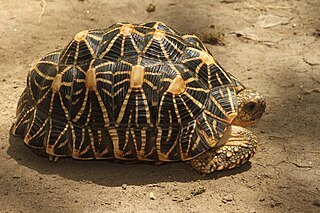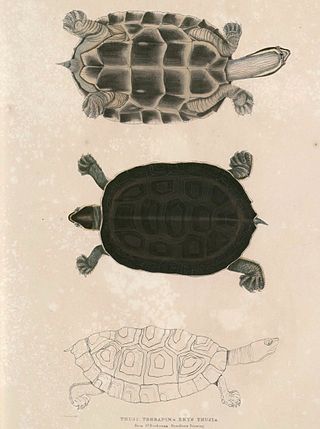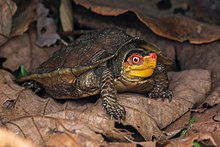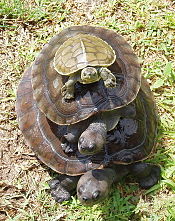
The Geoemydidae are one of the largest and most diverse families in the order Testudines (turtles), with about 70 species. The family includes the Eurasian pond and river turtles and Neotropical wood turtles. Members of this family are commonly called Leaf turtle.

The Arakan forest turtle is a critically endangered turtle species native to the Arakan Hills in western Myanmar and the bordering Chittagong Hill Tracts in Bangladesh. The Arakan forest turtle is a semiterrestrial turtle, meaning it can survive in aquatic as well as terrestrial habitats, but adults prefer living in terrestrial habitats.

Heosemys is a genus of freshwater turtles in the family Geoemydidae. The genus Heosemys was split out of the related genus Geoemyda by McDowell in 1964.

Siebenrockiella leytensis is a species of freshwater turtle endemic to the Philippines. It is classified as critically endangered. It is known as the Philippine forest turtle, the Philippine pond turtle, the Palawan turtle, or the Leyte pond turtle. Despite the latter common name, it does not occur in the island of Leyte but is instead native to the Palawan island group. It is locally known as bakoko in Cuyonon.

The spiny turtle is a South-East Asian turtle species. It inhabits lowland and hill rainforest, usually dwelling in the vicinity of small streams in hill areas up to 1,000 m above sea level. It is found in Brunei, Indonesia, Malaysia, Myanmar, the Philippines, Singapore, and Thailand.

The Indian star tortoise is a threatened tortoise species native to India, Pakistan and Sri Lanka where it inhabits dry areas and scrub forest. It has been listed as Vulnerable on the IUCN Red List since 2016, as the population is thought to comprise more than 10,000 individuals, but with a declining trend. It is threatened by habitat loss and poaching for the illegal wildlife trade. It was upgraded to CITES Appendix I in 2019 by full consensus among all member states, giving it the highest level of international protection from commercial trade. Conservation group TRAFFIC found 6,040 were seized globally that were intended to be sold in the pet trade.

The Indian black turtle or Indian pond terrapin is a species of medium-sized freshwater turtle found in South Asia.

The black pond turtle, also known commonly as the spotted pond turtle and the Indian spotted turtle, is a species of freshwater turtle in the family Geoemydidae. The species, which is endemic to South Asia, belongs to the monotypic genus Geoclemys.

The brahminy river turtle or crowned river turtle is a species of turtle in the family Geoemydidae. The species is endemic to South Asia.

The brown roofed turtle is a species of turtle in the family Geoemydidae. The species is endemic to South Asia. Two subspecies are recognized.

The Indian roofed turtle is a species of turtle in the family Geoemydidae. It can be distinguished by the distinct "roof" at the topmost part of the shell. It is found in the major rivers of South Asia. It is a common pet in the Indian Subcontinent.

The big-headed pantanal swamp turtle or pantanal swamp turtle is a species of turtle in the family Chelidae found in Brazil, Bolivia, Argentina, and Paraguay.

The yellow-footed tortoise, also known as the Brazilian giant tortoise, is a species of tortoise in the family Testudinidae and is closely related to the red-footed tortoise. It is found in the Amazon Basin of South America. The species name has often been misspelled as denticulata, an error introduced in the 1980s when Chelonoidis was elevated to genus and mistakenly treated as feminine, an error recognized and fixed in 2017.

Geoemyda is a genus of freshwater turtles in the family Geoemydidae. It contains two species:
The Sulawesi forest turtle is a critically endangered species of turtle in the family Geoemydidae. The species is monotypic within the genus Leucocephalon. It is endemic to Sulawesi in Indonesia.

Siebenrockiella crassicollis is a freshwater turtle endemic to Southeast Asia. It is one of two species classified under the genus Siebenrockiella in the family Geoemydidae.

The turtle shell is a shield for the ventral and dorsal parts of turtles, completely enclosing all the vital organs of the turtle and in some cases even the head. It is constructed of modified bony elements such as the ribs, parts of the pelvis and other bones found in most reptiles. The bone of the shell consists of both skeletal and dermal bone, showing that the complete enclosure of the shell likely evolved by including dermal armor into the rib cage.

Cyclemys is a genus of freshwater turtles, commonly referred to as Asian leaf turtles, from the family Geoemydidae. The genus occurs throughout Southeast and South Asia, and currently contains seven species.

The Assam leaf turtle is a species of turtle in the family Geoemydidae. The species is native to India, Nepal, Bhutan, and Bangladesh.

The Myanmar brown leaf turtle is a species of Asian leaf turtle found in Myanmar.






















